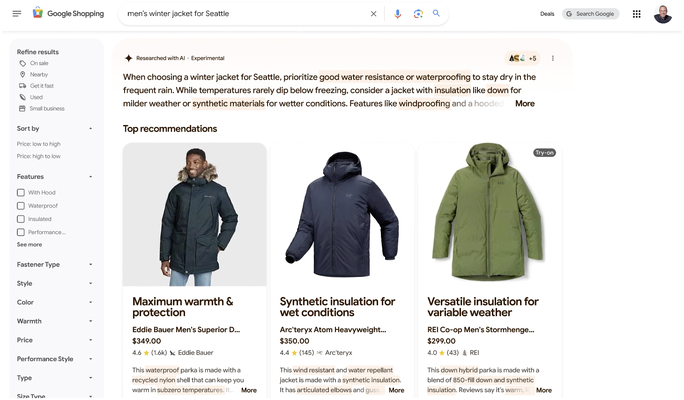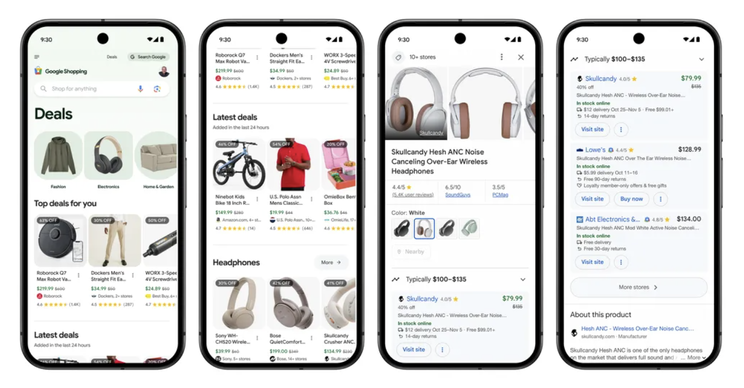Subscribe to join thousands of other ecommerce experts

If you had any doubts that Google is going to double (and triple) down on AI, then their latest updates to Google Shopping are probably going to throw you for a loop. One particularly curious change in the auction dynamics between PMax and Standard Shopping has caused an earthquake in the world of PPC.
In short: Google promises unprecedented targeting and personalization in your Shopping experience through the power of their machine learning.
Read on to find out what these BIG changes will mean for your current Ads strategies – as well as the (surprising) opportunities that lie therein.
It’s time to ride Google’s new AI wave!
It’s no secret that Google is pushing AI-driven enhancements across their entire ecosystem.
Recently, Google rolled out some big updates to Shopping Ads, and there’s a lot to unpack here.
🦸 Personalized Product Briefs with AI
Google’s AI-generated product briefs aim to personalize product listings based on the user’s specific search query.
The idea is that, if a user searches for “eco-friendly water bottles,” Google’s AI will curate product details to highlight attributes like sustainability, materials, and certifications.
This nifty feature presents a great opportunity to highlight the niche and specialized appeal of your catalogue. But to get the most out of it, it’s high time for you to –
- Optimize your product titles, attributes and descriptions to ensure Google’s AI captures and highlights your USPs effectively:
Listing just “brand” and “product type” won’t cut it anymore. To help Google’s AI craft spot-on product briefs, your feed needs the full story: materials, dimensions, seasonality, and standout features. The richer the detail, the better Google can align your products with user intent – and that means more relevance, more clicks, and better results. - Run experiments with variations in descriptions to understand what resonates most, especially for niche or specialized searches.

🎯 Dynamic filters for enhanced shopping experiences
Now this is a big deal.
Google’s new Dynamic Filters react in real-time to each user’s browsing behavior. For example, if a customer consistently chooses filters related to “organic,” “affordable,” or “high-quality,” the results dynamically prioritize products matching these criteria.
For the end-user, this will undoubtedly make their browsing experience more relevant. However, if your product listings are not set-up for this, it might completely shift how your ads appear based on these behavior-driven filters.
Just like the new Product Briefs, the accuracy and responsiveness of Dynamic Filters relies heavily on the quality and consistency of your product feed data. To maintain visibility in search results, ensure your feed is enriched with detailed, granular data.
🔁 Consistent data updates are key: Keep your product information precise and up-to-date, reflecting any new inventory, feature adjustments, or shifts in consumer preferences. Real-time filters depend on this accuracy to display the most relevant products.
💸 Finding better deals with AI
Shoppers now have access to tools like price comparisons, insights, and tracking throughout their shopping experience.
Plus, a new “Deals” page provides personalized offers and the latest discounts curated by AI based on user preferences.

Make no mistake: This definitely means competition will ramp up as retailers fight for the top spot in these listings. However, it also presents an opportunity to be more strategic with pricing and promotions.
- We recommend regularly reviewing Google’s price benchmarks and analyze market trends to identify strategic opportunities.
- You might then use this information to adjust pricing based on competitor movements or seasonal demand changes, maintaining your edge in real-time.
Stand out with strategic promotions: With AI curating personalized deals, success isn’t just about offering the lowest price—it’s about strategic relevance. Use targeted promotions or limited-time discounts on high-margin or popular products to stand out and attract buyer interest effectively.
🫶”It’s dangerous to go alone!”
In a nutshell, this is Google’s biggest feature roll-out in quite a while and we believe it will fundamentally change Shopping’s DNA.
These new features provide unique ways to refine and boost your Google Shopping campaigns, but many retailers are understandably hesitant to dive right in.
Google is effectively “black boxing” their Shopping ads even further, which can be tough if you have specific strategic goals you believe Google’s intransparent automation might miss.
That being said, automation is here to stay, and adapting to it while finding ways to steer it is crucial more crucial thant ever.
If you are dreading the “robocalypse”, DON’T! Read our blog post on the indispensible need for human strategizing in AI driven performance marketing.
Google’s PMax / Standard Shopping AdRank shenanigans
Believe it or not non-believers: Google might have done something – objectively – good this time around. Huh!
Look, this seismic shift hit us so unexpectedly that we are kinda at a loss for words, okay?

🏈 Levelling the playing field?
As our very own Mike Ryan reported over at Twitter, Google is making a game-changing update to how Performance Max (PMax) and Standard Shopping campaigns compete within the same account.
What’s in:
- Previously, PMax automatically took priority when both campaigns targeted the same products.
- Now that Google is throwing advertisers a bone for the holiday season, the ad with the highest Ad Rank will serve instead.
🤔 Why this matters?
In an ideal scenario, this should mean greater flexibility and control for advertisers, simplifying campaign testing and optimization.
In a nutshell, this update could lead to improved efficiency and flexibility, particularly during the holiday rush.
🔭 What’s next?
Ultimately, we don’t believe this change will have as much of an impact as Google would like you to believe. PMax remains the stronger campaign type. Covering all of Google’s Ad offerings, including Standard Shopping.
Instead of running through the door head first, expect a waaay more detailed rundown on this change in AdRanks and what it will mean for your campaigns in our Newsletter. Sign up and stay tuned!

